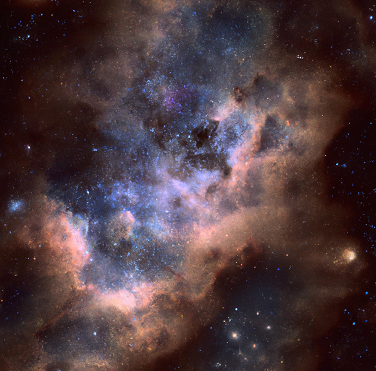How to see a Nebula With A Telescope?

A nebula is a cloud of gas and dust composed of Helium, Hydrogen, and other ionized gasses. They become visible from Earth due to the interaction of gas with other materials or supernova explosions. However, it is possible to see a nebula with a telescope. Typically a nebula looks gray though the view improves with the aperture size of the scope. The appearance of each Nebula is unique due to its own composition and also because they vary in size and distance from the earth.
Quick Guide to Observe Nebula
When there is no light pollution and the sky is absolutely dark, this is the greatest time to view nebulae. The nebula you want to see should be centered in the finder as you point your telescope in its direction. For a closer look, use an eyepiece with the lowest magnification and highest focal length. For this, a Barlow lens or 20 mm eyepiece works nicely. Check the finder scope alignment once more if you have trouble detecting the nebula. If you can see the nebula, examine and adjust your focus. To achieve better contrast, use filters. You may see the nebulae’s hues with a 10–14 inch aperture and a 100x–400x magnification.
Before starting, choose a Star app, it will help you with Nebula observation.
There are a lot of astronomy apps that show the sky objects available on that night with details. Stellarium, SKySafari, Google Sky, Star Tracker, and more which you can use to find which Nebular you are going to observe tonight.
How to find Nebula?
- Point your telescope toward the Nebula you want to observe and center it in the finder.
- Choose an eyepiece with the lowest magnification power and the highest focal length possible for a closer look. A Barlow lens or 20 mm eyepiece works great for this. If you find a problem detecting the nebula, check again the alignment of the finder scope.
- If you can spot the nebula, check your focus and fix it.
What is the best time to observe Nebula?
Some nebulae appear bright in the sky and others look faint. The best time to view Nebulae is when the sky is completely dark i.e. no light pollution is there. Light pollution will affect your view regardless of how big the aperture or powerful a telescope you use.
5 Tips to observe Nebula in the best way.
- Cup your hands around your eyes or head to block extra light to make the view clear.
- Sit comfortably and focus on your view.
- Choose a higher location if possible.
- Avoid light-polluted areas.
- Use filters to get better contrast.
What Nebulae are best to observe with a telescope?
- The brightest Nebula Orion is the easiest to find with a telescope. This is one of the most studied Nebulae that helped to understand a lot of planetary systems and stars. The huge collection of gas, massive stars, brown dwarfs, and protoplanetary disks makes it attractive to observe. 8 inch telescopes are great for this.
- With an 11-inch telescope, you may find supernova remnants and planetary nebulae like the Ring Nebula and the Dumbbell Nebula.
- The Lagoon Nebula is also visible like a giant oval cloud with a distinct core.
- Cygnus, Perseus, and Cassiopeia can also be spotted easily.
- With a 10-inch scope, you will see the M27 star in Dumbbell Nebula a little bit of orange. But with a 16 inch telescope, you will be able to see bluish or greenish color in M27.
What telescope to see Nebula?
Celestron Starsense Explorer 10″ Dobsonian, Sky-Watcher 12″ f/3.93 Quattro Imaging Newtonian, and Meade 16 LX 600 ACF f/ 8 are great telescopes to see Nebula. A list of telescopes to see Nebula has more telescope options that can see Nebula very clearly.
What size telescope to see Nebula?
You need at least a 6-inch telescope to see a Nebula. It is easier to spot them using 8-inch telescopes with at least 1000mm of focal length. But they will not reveal the color of all the nebulae. You need at least a 10-inch telescope to see the color of different nebulae.
What magnification is required to observe Nebula?
The magnification of the telescope to observe a Nebulae should be at least 75x-100x. If the telescope allows more magnification, you can use that to get better views. 100x-400x magnification with a 10-14 inch aperture will allow you to sense the colors of the nebulae.
What filters are the best to see Nebula?
- Narrowband light pollution reduction filters can be used with a 6-inch telescope. They darken the background and increase the contrast of the view.
- Oxygen-three (OIII) or Ultra-High-Contrast (UHC) filters can be used with larger telescopes with 8-inch or more aperture which block most of the wavelengths.
- Deep Sky filters can be used to improve the images.
Enjoying Nebula? Here are other things to see with your telescope.
There are more than 3000 Nebulae that can be identified and observed by a telescope. Orion Nebula is one of the brightest Nebulae that is widely observed. Viewing Orion Nebula Through A Telescope can be a guide to you if you intend to observe Orion. There are myriad celestial objects you can observe with the same telescope you use to see a nebula. Galaxies, Stars, asteroids, planets of our solar system and their satellites, and many other objects appear with their amazing details. ‘List of things to see with a telescope’ can guide you on how to observe different gems of the night sky.
